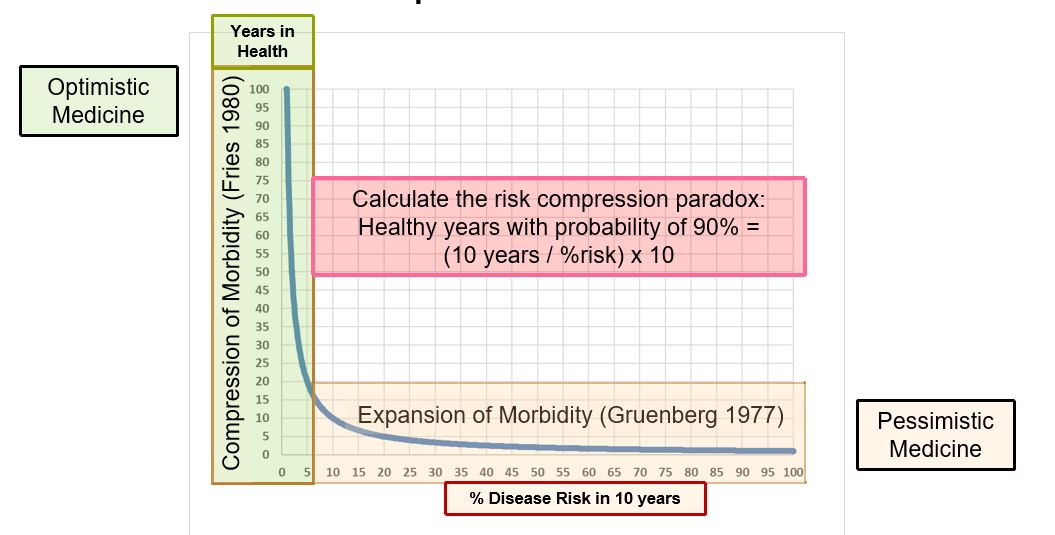Optimism and Pessimism in Medicine, a point of view regarding expansion and compression of morbidity: the “Risk Compression Paradox”
Basel, Switzerland, January 10th, 2017
OPTIMISM AND PESSIMISM IN MEDICINE, POINT OF VIEW REGARDING THE EXPANSION AND COMPRESSION OF MORBIDITY: THE “RISK COMPRESSION PARADOX”
Improvements in medicine are impressive, and medicine is able to save more and more people from diseases that used to be lethal, but the dilemma of modern medicine is to postpone death at the expense of an increase in the number of diseases occurring in an aging population [1]. This leads to higher costs and thus to a call for cutting back medicine, since it would no longer be financially sustainable. Although such diseases are more and more manageable, considerable cost issues arise due to toxic price schemes, such as anti-cancer or lipid-lowering drugs [2]. Medicine is now in the remarkable position of having become somewhat a victim of its own success.
The perception of the positive effects of medicine has been challenged further by Ernest M. Gruenberg in a report by Milbank Quarterly in 1977 [1]. He pessimistically viewed the ability of medicine to avert death as potentially negative because it would lead to an expansion of disease. in fact: the ultimate medical victory over diseases must generate an expansion of morbidity in order to nourish the cybernetic learning system that makes this goal achievable.
The plethora of medicine inevitably creates a movement of criticism and opposition, which points to the fact that medicine may have iatrogenic and pathogenic effects. This movement increasingly and successfully criticizes the expansion of medical indications for curative and palliative procedures. Regarding prevention, medicine is highly effective, but there are application problems. Refusal to medicalize a life with preventive pills is a common skeptical and pessimistic attitude, where side effects of preventive therapies are purposefully exaggerated and beneficial effects downplayed. The consequence is not only a rejecting attitude towards vaccinations [3], but also of palliative medicine replaced by assisted suicide using Pentobarbital (EXIT movement in Switzerland). Such movements fit well with the utilitarian viewpoint: no waste of limited resources [4]. At the same time, in the economization of society, namely the productive value of humans is used when deciding to withhold costly interventions, concealed behind economical calculations regarding quality adjusted life years (QALY). “Why I Hope to Die at 75” expressed by the bioethicist Ezechiel Emanuel points to the victory of economic values over the use of medical services [5].
The optimistic view of the situation is completely different. since diseases may be prevented until natural death occurs. This concept was formulated in 1980 by James Fries [6] and has recently been substantially verified using a 40-year observation: individuals 40 years later with a favorable risk profile for cardiovascular disease had an absolute compression of morbidity and associated costs [7].
There is a simple mathematical relationship between risk and healthy life expectancy. We term our observation the “risk compression paradox”, which can be calculated by “healthy years with probability of 90% = (10 years / %risk) x 10”. As can be seen in the central figure, a high (90%) probability to gain healthy years appears exponential, once risk is below 5% in 10 years. The expansion of healthy years as a gain due to compression of morbidity is extremely high, when we lower low risk even further (e.g. from 7% to 2% with a gain of 36 years), whereas in persons with higher risk, equal amounts of absolute risk reduction will not increase the probability to remain healthy but for a few years. This view will strengthen preventive medicine, because it shows, where the camp of pessimists and optimists separate (see figure).
Conviction, education, financing and encouragement will increase the effectiveness of preventive medicine, resulting in a shift from disease expansion to disease compression. The solution of the conundrum of a failing medicine, which creates diseases in increasingly viable humans lies in the optimistic answer towards maximized prevention. This will weaken the skills of future medicine, because medicine will lose many patients. The optimists’ strategy, accomplishes its goal by rationally applying medical knowledge using proven efficiency of prevention in order to compress morbidity in an increasingly healthy and productive society. Public Health has to focus on perfecting evidence-based prevention, elimination of anti-preventive irrational and scientifically unsustainable pseudo-falsifications and aim to create a climate of trust in the strengths of preventive medicine.
References:
1. Gruenberg EM. The Failures of Success. Milbank Mem Fund Q [Internet]. 1977;55(4):3–24. Available from: www.ncbi.nlm.nih.gov/pmc/articles/PMC2690285/pdf/milq0083-0400.pdf
2. Eichler H-G, Hurts H, Broich K, Rasi G. Drug Regulation and Pricing — Can Regulators Influence Affordability? N Engl J Med [Internet]. 2016;374(19):1807–9. Available from: http://www.nejm.org/doi/10.1056/NEJMp1601294
3. Yaqub O, Castle-Clarke S, Sevdalis N, Chataway J. Attitudes to vaccination: A critical review. Soc Sci Med [Internet]. Elsevier Ltd; 2014;112:1–11. Available from: http://dx.doi.org/10.1016/j.socscimed.2014.04.018
4. Scheunemann LP, White DB. The ethics and reality of rationing in medicine. Chest. 2011;140(6):1625–32.
5. Emanuel E. Why I hope to die at 75 [Internet]. The Atlantic. 2014. Available from: http://www.theatlantic.com/magazine/archive/2014/10/why-i-hope-to-die-at-75/379329/
6. Fries J. Aging, natural death, and the compression of morbidity. N Engl J Med. 1980;303:130–5.
7. Allen NB, Zhao L, Liu L, Daviglus M, Liu K, Fries J, et al. Favorable Cardiovascular Health, Compression of Morbidity, and Healthcare CostsClinical Perspective. Circulation. 2017;135(18):1693–701.
Comment
This is a scientific website of the vascular risk foundation. In an aging population, the compression of morbidity towards the end of life is achievable, when control of risk factors in middle age is favorable. The magnitude of such effects is the key research object in our population of 5’352 healthy subjects from Germany and Switzerland.
This website is in preparation. The german website is available with the key informations here.

